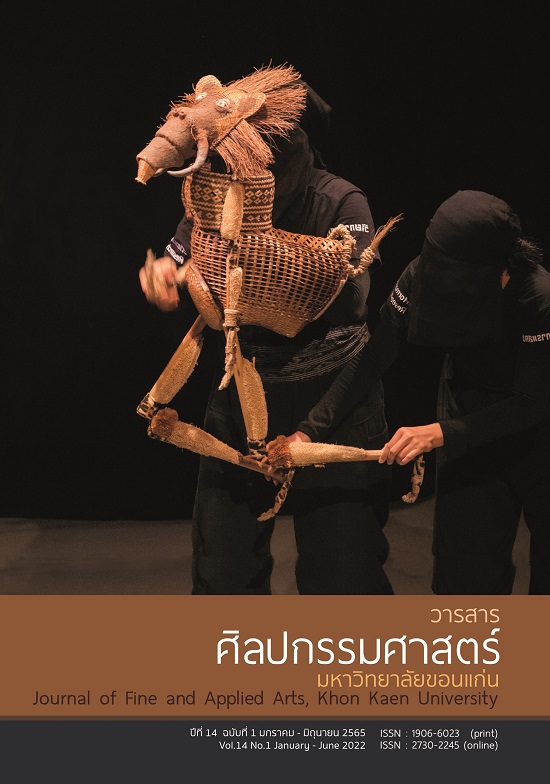Creativities of Sculptures: Father Form of Thought
Main Article Content
Abstract
The creation aimed to study, analyze, and interpret the creator’s imaginary experience with the father for the synthesis of the creative process. The data collection of from documentary and field study from rural villages in Isan region [The North-Eastern side of Thailand] and then bring it to analyze and explain according to the conceptual framework, the theory is combined with the ideas, emotions and fantasies. The process include sketching, procurement, and preparation of materials, and creative work.
The results of the study show: The image of father, representing the man of the Isan region who work in agriculture career and he also work hard to build a stable life and family amidst the social changes in the Isan rural from farming for household consumption to agriculture for industrial production by using manpower and existing tools. It is a difficult and exhausting life. That led to the creation of 3 sculptures were made using the form of bones which were carved from old wood. The main component of the house uses agricultural tools such as tractors wheels, hoe, and rice bat. The effect is when form, materials and assembly create a harmonious effect together with unity. These are making the work which able to create imagery conveys and give a feeling of use body organs to work. Heavy drag exertion of physical strength and insecurity which is the images that the creator have seen them since childhood, in family and in general in the Isan countryside.
The results have contributed the body of knowledge in searching for forms and materials that relating to each other in both physically and meaningfully. The studies, analysis, content interpretations, as well as the inspirational stories enabled the conceptual framework to select forms and materials that correspond to the aims of the creation explicitly. The straightforward management with materials and compositions of the images made the works attractive and showed aesthetics in terms of the contents, forms, materials, and complete appearances. The creations, therefore, either reflected the attitude, idea, experiences, and feelings of the artist apparently.
Article Details

This work is licensed under a Creative Commons Attribution-NonCommercial-NoDerivatives 4.0 International License.
Content and information in articles published in the Journal of Fine and Applied Arts of Khon Kaen University is regarded as the opinion and sole responsibility of the author(s) directly; therefore, editors are not obliged to agree to or share any responsibility with regard to the content and information that appears within these articles.
All articles, information, content, image, etc. that have been published in the Journal of Fine and Applied Arts of Khon Kaen University is the copyright of the Journal of Fine and Appllied Arts of Khon Kaen University. Any person or organization who wishes to distribute all or parts of the articles for further dissemination or other usage must first receive permission from the Journal of Fine and Applied Arts of Khon Kaen University before proceeding to do so.
References
กระดูกต้นขา. (2557). ค้นเมื่อ 13 พฤศจิกายน 2562, จาก https://miwekumako.files.wordpress.com/ 2014/05/condyle.jpg
กาญจนา แก้วเทพ. (2552). การวิเคราะห์สื่อ แนวคิดและเทคนิค. กรุงเทพฯ: คณะนิเทศศาสตร์ จุฬาลงกรณ์มหาวิทยาลัย.
ชลิต ชัยครรชิต และคณะ. (2544). สังคมและวัฒนธรรมอีสาน. ขอนแก่น: คลังนานาวิทยา.
ดิตถพงษ์ บุญอำพล. (ม.ป.ป.) หยุดปวดชีวิตเปลี่ยน: ความรู้ทั่วไปเกี่ยวกับกระดูก. ค้นเมื่อ 10 มกราคม 2563, จาก https://www.bangkoklifenews.com/17127622/newsoo4
ประชาชาติธุรกิจ. (2561). เศรษฐกิจภูมิภาค: สมาคมมันสำปะหลังอีสาน เตือนเกษตรกรระวังโรคใบด่าง
ชี้หากเกิดผลผลิตเสียหายกว่า 80%. ค้นเมื่อ 13 มกราคม 2563, จาก https://www.prachachat.net/ local-economy/news-233296
พิสณฑ์ สุวรรณภักดี. (2562). ศักยภาพของวัตถุสำเร็จรูปและวัสดุเก็บตกต่อความทรงจำระดับปัจเจกกับความทรงจำร่วมของคนในสังคม กรณีศึกษาจากผลงานของ โจเซฟ บอยส์ และ มารีนา อบราโมวิก. วารสาร Veridian E-Journal, Silpakorn University, 12(6), 2087-2088.
มณเฑียร บุญมา. (2532). ภาพ: รูปลักษณ์จากวัสดุ เรื่องราวจากท้องทุ่ง สูจิบัตรการแสดงผลงานสื่อประสม ชุดเรื่องราวจากท้องทุ่งของมณเฑียร บุญมา, 14 กรกฎาคม – 1 สิงหาคม 2532 ณ พิพิธภัณฑสถานแห่งชาติ หอศิลป กรุงเทพมหานคร. กรุงเทพฯ: [ม.ป.พ.].
ฤทธิ์ ลูกอีสาน. (2562). คนแบกอ้อยใส่รถอีแต๋น #รถอีแต๋นอ้อยเต็มคันออกจากไร่. ค้นเมื่อ 13 มกราคม 2563, จาก https://www.youtube.com/watch?v=ndf9zpeSYhA
วิกิพีเดีย. (2548). กระดูกต้นแขน. ค้นเมื่อ 13 พฤศจิกายน 2562, จาก https://th.wikipedia.org/wiki/กระดูกต้นแขน#/media/ไฟล์:Humerus_ant.jpg
วิกิพีเดีย. (2560). กระดูกเรเดียส. ค้นเมื่อ 13 พฤศจิกายน 2562, จาก https://th.wikipedia.org/wiki/กระดูกเรเดียส#/media/ไฟล์:RightHumanPosteriorRadiusUlna.jpg


